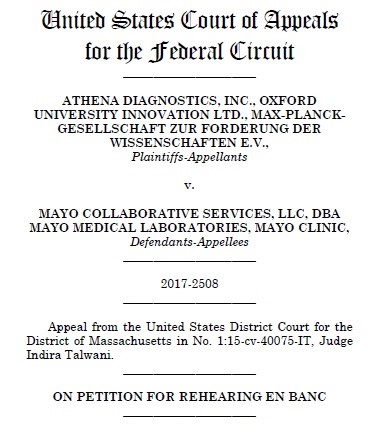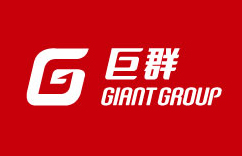【智財評析】「醫療診斷方法」專利適格性之大混戰:聯邦巡迴上訴法院駁回Athena v. Mayo案全院庭審聽證裁定之評析
2019-09-25 陳志清 律師/專利師(資格)

美國聯邦巡迴上訴法院之所有法官於2019年7月3日,以7比5的結果作出Athena Diagnostics, Inc. v. Mayo Collaborative Services, LLC一案之裁定[附註1],駁回全院庭審聽證(en banc hearing denied)之請求,然而僅僅四頁的法院裁定書,卻伴隨著一共有八份的協同意見書、或是不同意見書,各個法官表達出了自己的意見。因此,關於「醫療診斷方法」專利(medical diagnostic patents)之專利適格性(eligibility)問題變成一場大混戰,頗值得讀者注意後續發展!
案件背景事實
1. 原告為Athena Diagnostics, Inc.、Oxford University Innovation Ltd.、以及Max-Planck Gesellschaft zur Forderung der Wissenschaften e.V.(以下合稱”Athena”)。Max-Planck為系爭專利的專利權人之一,Athena Diagnostics則為系爭專利的專屬被授權人。系爭專利為美國第7,267,820號專利(以下簡稱’820專利),係關於一種經由檢測哺乳類動物中的「肌肉特異性酪氨酸激酶」(muscle specific tyrosine kinase,簡稱MuSK)之自身抗體來診斷神經障礙(diagnosing neurological disorders)的方法,而Athena同時也行銷一種稱為FMUSK的檢測方法來評估該些自身抗體。真正要詳細瞭解該檢測技術,可能需要生醫相關背景的人員、或者是從事相關醫療診斷領域的業者才有辦法吧!
2. 而被告被控侵權人為Mayo Collaborative Services, LLC,以Mayo Medical Laboratories及Mayo Clinic之名義營業(以下合稱”Mayo”)。Mayo也發展出兩種類似的檢測方法,並宣稱其實施一個或多個在’820專利中的申請專利範圍之每一步驟,來與Athena於市場上相競爭。於2015年6月2日,原告Athena於聯邦地方法院控告被告Mayo侵害其專利,被告Mayo則依據聯邦民事訴訟規則之Rule 12(b)(6)提起撤銷案件的動議(motion to dismiss),指稱’820專利的系爭申請專利範圍並不符合專利適格性而應該無效。
3. ‘820專利之系爭申請專利範圍為第6項至第9項[附註2],其中,申請專利範圍獨立項第1項與其附屬項第7項原文如下所示:
1. A method for diagnosing neurotransmission or developmental disorders related to muscle specific tyrosine kinase (MuSK) in a mammal comprising the step of detecting in a bodily fluid of said mammal autoantibodies to an epitope of muscle specific tyrosine kinase (MuSK).
7. A method according to claim 1, comprising contacting MuSK or an epitope or antigenic determinant thereof having a suitable label thereon, with said bodily fluid, immunoprecipitating any antibody/MuSK complex or antibody/MuSK epitope or antigenic determinant complex from said bodily fluid and monitoring for said label on any of said antibody/MuSK complex or antibody/MuSK epitope or antigen determinant complex, wherein the presence of said label is indicative of said mammal is suffering from said neurotransmission or developmental disorder related to muscle specific tyrosine kinase (MuSK).
4. 聯邦地方法院於2017年8月4日作出判決[附註3],主要就是基於聯邦最高法院先前於2012年所作出之Mayo案判決、以及於2014年所作出之Alice案判決所建立的專利適格性測試標準,地方法院認為系爭申請專利範圍係「指向」(directed to)「自然法則」(a law of nature);接者,地方法院認為系爭申請專利範圍主要係針對體液中的MuSK自身抗體與具有125I標記的MuSK間的交互反應,為一種自然發生的交互反應(the interaction of 125I-labeled MuSK with MuSK autoantibodies in bodily fluid, an interaction which occurs naturally);且地方法院認為系爭申請專利範圍中的步驟僅涉及「該領域中的標準技術」(standard techniques in the art),故亦缺少「創造概念」(inventive concept),故經分析後認為不滿足專利適格性的要件,該些申請專利範圍無效。因此,地方法院同意被告Mayo的撤銷案件動議;原告Athena不服,向聯邦巡迴上訴法院提起上訴。
5. 於2019年2月6日,美國聯邦巡迴上訴法院作出判決[附註4],維持聯邦地方法院之上述判決結果,指出’820專利之系爭申請專利範圍係指向「自然法則」且僅以結合傳統的步驟來偵測該「自然法則」,並不符合專利適格性要件之要求,因此其依據35 U.S.C. §101之規定為無效,故地方法院之判決並無違誤。本案被告Mayo利用其先前的Mayo案例來打敗原告Athena的專利…。
6. 針對聯邦巡迴上訴法院該判決結果,原告Athena不服、請求該法院進行合議庭再聽證、或是請求進行全院庭審聽證。
案件爭點
本案件裁定內容的主要爭點,就是關於「醫療診斷方法」專利於什麼樣的條件下會滿足專利適格性的要件,因此,聯邦巡迴上訴法院需要決定是否要受理合議庭再聽證、或是全院庭審聽證之請求。
相關法律規定
1. 美國專利法第101條係規定具有可專利性的發明,包括:任何人創造或是發現任何新的且有用的方法(process)、機器(machine)、製品(manufacture)、或是組合物(composition of matter),或是再加上對前述之任何新的且有用的改良(improvement),可取得專利,原文如下:
35 U.S. Code § 101 -- Inventions patentable
Whoever invents or discovers any new and useful process, machine, manufacture, or composition of matter, or any new and useful improvement thereof, may obtain a patent therefor, subject to the conditions and requirements of this title.
2. 美國聯邦最高法院於2012年所作出之Mayo案判決[附註5],以及於2014年所作出之Alice案判決[附註6],建立起了關於專利適格性測試標準之「Mayo/Alice測試法」(Mayo/Alice test)、或稱為「兩步驟測試法」(two-part test)。透過聯邦巡迴法院之Athena案判決[附註7],讓我們再來複習一下該測試法應該如何操作吧!
首先,第一步驟需要判斷該申請專利範圍是否係「指向」(directed to)美國專利法的「法定專利適格標的之例外」(judicially recognized exceptions),其中包含有:「自然法則」(laws of nature)、「自然現象」(natural phenomena)、以及「抽象概念」(abstract idea)等三種不予專利之標的:
Under the law as set forth by the Supreme Court, § 101, while broad, “contains an important implicit exception. ‘[L]aws of nature, natural phenomena, and abstract ideas’ are not patentable.” Mayo, 566 U.S. at 70 (alteration in original) (quoting Diamond v. Diehr, 450 U.S. 175, 185 (1981)).
To distinguish claims to patent-eligible applications of laws of nature from claims that impermissibly tie up such laws, we apply the two-part test set forth by the Supreme Court. First, we examine whether the claims are “directed to” a law of nature. Alice, 573 U.S. at 217.
若是被判斷該申請專利範圍係指向「自然法則」的話,則進入第二步驟的判斷,看看於申請專利範圍中的任何元件是否有提供可「遠遠地超過」(significantly more than)於該不具專利適格性之概念本身:
At step two, “we consider the elements of each claim both individually and ‘as an ordered combination’ to determine whether the additional elements ‘transform the nature of the claim’ into a patent-eligible application.” Alice, 573 U.S. at 217 (quoting Mayo, 566 U.S. at 78, 79). “Purely ‘conventional or obvious’ ‘[pre]-solution activity’ is normally not sufficient to transform an unpatentable law of nature into a patent-eligible application of such a law.” Mayo, 566 U.S. at 79 (second alteration in original) (quoting Flook, 437 U.S. at 590). The transformative “inventive concept” supplied by the claim elements not drawn to ineligible subject matter must be “sufficient to ensure that the patent in practice amounts to significantly more than a patent upon the [ineligible concept] itself.” Alice, 573 U.S. at 217–18 (quoting Mayo, 566 U.S. at 73).
聯邦巡迴上訴法院見解
1. 於2019年7月3日,聯邦巡迴上訴法院之所有法官以7比5的投票結果,駁回了原告Athena所提出的關於「醫療診斷方法」專利之適格性問題的全院庭審聽證之請求、也駁回了合議庭再聽證的請求(panel rehearing denied)。
2. 然而,前述裁定書雖然才短短的4頁,但是卻招來了聯邦巡迴上訴法院之法官們分別作出了8份的協同意見書(concurring opinion)、或是不同意見書(dissenting opinion),一共有82頁,各抒己見、表達法官自己的立場。其中,各法官之見解如下表所示:
| 意見書 | 法官 | 相關意見 |
| (1) | Lourie法官之協同意見書 (Reyna法官、以及Chen法官加入) |
Lourie法官贊同不應全院庭審聽證本案。因為即使作了再聽證,聯邦巡迴上訴法院仍然需受到聯邦最高法院的Mayo案之拘束。另外,Lourie法官認為並不應該排除使用或偵測「自然法則」之相關發明。 I concur in the court’s decision not to rehear this case en banc. In my view, we can accomplish little in doing so, as we are bound by the Supreme Court’s decision in Mayo. * * * If I could write on a clean slate, I would write as an exception to patent eligibility, as respects natural laws, only claims directed to the natural law itself, e.g., E=mc2, F=ma, Boyle’s Law, Maxwell’s Equations, etc. I would not exclude uses or detection of natural laws. The laws of anticipation, obviousness, indefiniteness, and written description provide other filters to determine what is patentable. But we do not write here on a clean slate; we are bound by Supreme Court precedent. |
| (2) | Hughes法官之協同意見書 (Prost首席法官、以及Taranto法官加入) |
Hughes法官同意對「醫療診斷方法」之專利適格性判斷是有問題的,然而,Hughes法官認為這並非聯邦巡迴上訴法院可以解決的問題,仍需要受到聯邦最高法院判決的拘束。因此,期待對「醫療診斷方法」之專利適格性標準有一個更進一步的解釋。 I also agree, however, that the bottom line for diagnostics patents is problematic. But this is not a problem that we can solve. As an inferior appellate court, we are bound by the Supreme Court. I, for one, would welcome further explication of eligibility standards in the area of diagnostics patents. |
| (3) | Dyk法官之協同意見書 (Hughes法官加入、而Chen法官則是加入IV、V以及VI部分) |
Dyk法官認為聯邦最高法院的Mayo案與其後2013年所作出的Myriad案處於緊張狀態,且Mayo案判決的解釋過為廣泛。因此,這應該是一個讓聯邦最高法院重新細緻化”Mayo framework”,用以核准已經具有足夠特定的診斷方法之申請專利範圍的好機會。 (Part IV) It is nonetheless appropriate to point out that there is tension between Mayo and the Supreme Court’s later decision in Association for Molecular Pathology v. Myriad Genetics, Inc., 569 U.S. 576 (2013), and that the holding of Mayo may be overbroad. The language of § 101 does cover “discover[ies],” 35 U.S.C. § 101, and there is no doubt that determining the relationship between specific genetic abnormalities and specific diseases constitutes an important discovery with proven utility. There is much to be said for the patentability of claims to such discoveries, if not drafted overbroadly. * * * Thus, it would be desirable for the Supreme Court to refine the Mayo framework to allow for sufficiently specific diagnostic patent claims with proven utility. Athena Diagnostics, Inc. v. Mayo Collaborative Services, LLC, No. 2017-2508 (Fed. Cir. 2019) (Dyk, J., concurring in the denial of rehearing en banc). |
| (4) | Chen法官之協同意見書 | Chen法官贊同不應全院庭審聽證本案。即使Chen法官認為本案的系爭申請專利範圍依照”Diehr’s framework”應該是符合專利適格性的要件,但由於聯邦最高法院最近的Mayo案之論理清楚故仍應受其拘束。 While I believe our court would benefit from the Supreme Court’s guidance as to whether it intended to override central tenets of Diehr, Mayo’s reasoning is clear and we are bound by it. Because that analysis requires the affirmance of the district court’s decision to invalidate Athena’s claims, I concur with this court’s decision to deny the petition for rehearing en banc. * * * (Conclusion) Even though Athena’s claims likely would be found patenteligible under Diehr’s framework, it is not an inferior court’s role to dodge the clear, recent direction of the Supreme Court. |
| (5) | Moore法官之不同意見書 (O’Malley法官、Wallach法官、以及Stoll法官加入) |
Moore法官認為本案之系爭申請專利範圍應該是具有適格性,且其與聯邦最高法院的Mayo案內容是有區隔的。因此,聯邦巡迴上訴法院應該重新考慮本案以及釐清之前的判例。 The majority of my colleagues believe that our hands are tied and that Mayo requires this outcome. … The claims in this case should be held eligible, and they are distinguishable from Mayo. * * * (Conclusion) In the wake of Mayo, we have painted with a broad brush, suggesting that improved diagnostic techniques are not patent eligible. Mayo did not go so far, and given the import of diagnostic techniques, we should reconsider this case and clarify our precedent. |
| (6) | Newman法官之不同意見書 (Wallach法官加入) |
Newman法官認為聯邦最高法院的Mayo案並沒有建立起只要是診療方法就是不符合專利適格性要件的規則。因此,全院庭審聽證本案是需要的。 The majority’s position is a flawed interpretation of the Court’s decision in Mayo Collaborative Services v. Prometheus Laboratories, Inc., 566 U.S. 66 (2012). The Court did not hold that methods of diagnosis are subject to unique patent-eligibility rules. We have mistakenly enlarged the Court’s holding, in substance and in application. Rehearing en banc is warranted. |
| (7) | Stoll法官之不同意見書 (Wallach法官加入) |
Stoll法官認為聯邦巡迴上訴法院於聯邦最高法院的Mayo案之後,已經於一系列的診療專利相關之判決建立起一個清楚的不符合專利適格性要件之規則。因此,本案因為Mayo案而不具專利適格性的要件,但因為診療方法專利具有其重要性,且聯邦巡迴上訴法院應該藉此機會矯正上述之錯誤規則,故Stoll法官認為應該全院庭審聽證本案。 In a series of cases since the Supreme Court’s decision in Mayo Collaborative Services v. Prometheus Laboratories, Inc., 566 U.S. 66 (2012), we have established a bright-line rule of ineligibility for all diagnostic claims. … This rule as applied to the facts of this case dictated that the majority panel find the claimed invention ineligible. But, because this court’s bright-line rule is based on an over-reaching and flawed test for eligibility, a test that undermines the constitutional rationale for having a patent system—promoting the progress of science and useful arts—the court should take this opportunity to correct its erroneous rule. Athena Diagnostics, Inc. v. Mayo Collaborative Services, LLC, No. 2017-2508 (Fed. Cir. 2019) (Stoll, J., dissenting in the denial of rehearing en banc). |
| (8) | O’Malley法官之不同意見書 | O’Malley法官認為聯邦最高法院的Mayo案之解釋太過廣泛。尤其是聯邦最高法院指示下級法院應當於討論35 U.S.C. §101的專利適格性時討論「創造概念」,然其已經於1952年國會修正專利法時被移除。因而,在此促請國會應當重新修正專利法以釐清該問題。 I agree with all my dissenting colleagues that our precedent applies the Supreme Court’s holding in Mayo Collaborative Services v. Prometheus Laboratories, Inc., 566 U.S. 66 (2012) too broadly. I write separately, however, because I believe that confusion and disagreements over patent eligibility have been engendered by the fact that the Supreme Court has ignored Congress’s direction to the courts to apply 35 U.S.C. sections 101, et seq (“Patent Act”) as written. Specifically, the Supreme Court has instructed federal courts to read into Section 101 an “inventive concept” requirement—a baffling standard that Congress removed when it amended the Patent Act in 1952. I encourage Congress to amend the Patent Act once more to clarify that it meant what it said in 1952. |
3. 透過前述的數份意見書之內容我們可以約略看出,大多數的法官其實是傾向於認定本案Athena的系爭申請專利範圍是符合專利適格性的要件,但由於需要受到聯邦最高法院Mayo案的過於廣泛解釋結果之拘束而需被判斷為不具專利適格性;而且法官們還不約而同地表達了這種或是類似「醫療診斷方法」之專利案件頗具有重要性,這也是送給相關單位的一個重要訊息,或許還是需要再透過聯邦最高法院的進一步判決、或者是透過立法當局的國會(Congress)進一步修正專利法才能夠明確解決該具有頗大爭議的狀況(請參考[附註8]及[附註9])。
這個裁定書之結果應該可以列入年度最為混亂判決/裁定之排行榜第一名吧!這點從Hughes法官所撰寫的協同意見書內容第一句就可以看得出來:
The multiple concurring and dissenting opinions regarding the denial of en banc rehearing in this case are illustrative of how fraught the issue of § 101 eligibility, especially as applied to medical diagnostics patents, is.
小結
1. 這個案子原告Athena應該會再上訴到聯邦最高法院,依據各法官表達各自意見的這種混亂程度,相信最高法院應該是會受理本案的上訴聲請吧!
2. 針對這個專利適格性問題的案子,非常值得處理相關「醫療診斷方法」專利之業界同道多加研究,並觀察其後續發展!
本文章之專業內容,僅為提供資訊參考,非作為法律諮詢之用,亦純屬作者個人之意見,不代表本所或作者任何曾任職過單位之立場。
相關參考資料
附註1. 美國聯邦巡迴上訴法院駁回全院庭審之裁定:Athena Diagnostics, Inc. v. Mayo Collaborative Services, LLC, No. 2017-2508 (Fed. Cir., July 3, 2019) (en banc hearing denied) 案裁定原文(網址:http://www.cafc.uscourts.gov/sites/default/files/opinions-orders/17-2508.Order.7-3-2019.1.pdf)(最後瀏覽日期:2019年9月3日)。
附註2. ‘820專利之其他系爭申請專利範圍第6、8、及9項,原文如下:
6. A method according to claim 3 whereby the intensity of the signal from the anti-human IgG antibody is indicative of the relative amount of the anti-MuSK autoantibody in the bodily fluid when compared to a positive and negative control reading.
8. A method according to claim 7 wherein said label is a radioactive label.
9. A method according to claim 8 wherein said label is 125I.
附註3. 美國聯邦地方法院判決:Athena Diagnostics, Inc. v. Mayo Collaborative Servs., LLC, 275 F.Supp.3d 306 (D. Mass., August 4, 2017).8. A method according to claim 7 wherein said label is a radioactive label.
9. A method according to claim 8 wherein said label is 125I.
附註4. 美國聯邦巡迴上訴法院判決:Athena Diagnostics, Inc. v. Mayo Collaborative Services, LLC, 915 F.3d 743 (Fed. Cir., February 6, 2019) 案判決原文(網址:http://www.cafc.uscourts.gov/sites/default/files/opinions-orders/17-2508.Opinion.2-6-2019.pdf)(最後瀏覽日期:2019年9月3日)。
附註5. Mayo案判決:Mayo Collaborative Services v. Prometheus Laboratories, Inc., 566 U.S. 66; 132 S. Ct. 1289 (Supreme Court, March 20, 2012).
附註6. Alice案判決:Alice Corp. v. CLS Bank International, 573 U.S. 208 (Supreme Court, June 19, 2014).;另請參考相關評析文章,「【智財評析】美國專利法中電腦實施發明之專利適格性的「兩步測試法」:美國聯邦最高法院Alice v. CLS Bank案評析」,陳志清著,2019年7月18日,巨群事務所文章專欄,網址:http://www.giant-group.com.tw/law-detail-742.html(最後瀏覽日期:2019年9月17日)。
附註7. 同前附註4。
附註8. Dennis Crouch, “Athena Loses on Eligiblity – Although 12 Federal Circuit Judges Agree that Athena’s Claims Should be Eligible,” 2019/07/03, Patently-O blog,網址:https://patentlyo.com/patent/2019/07/eligiblity-although-eligible.html(最後瀏覽日期:2019年9月3日)。
附註9. Donald Zuhn, “Athena Diagnostics, Inc. v. Mayo Collaborative Services, LLC (Fed. Cir. 2019),” 2019/07/09, Patent Docs blog,網址:https://www.patentdocs.org/2019/07/athena-diagnostics-inc-v-mayo-collaborative-services-llc-fed-cir-2019.html(最後瀏覽日期:2019年9月3日)。
延伸閱讀:
消息來源:


